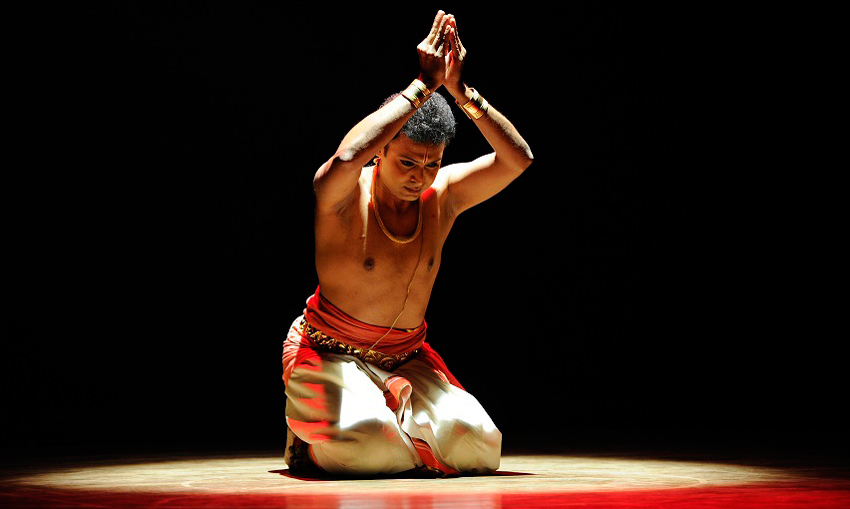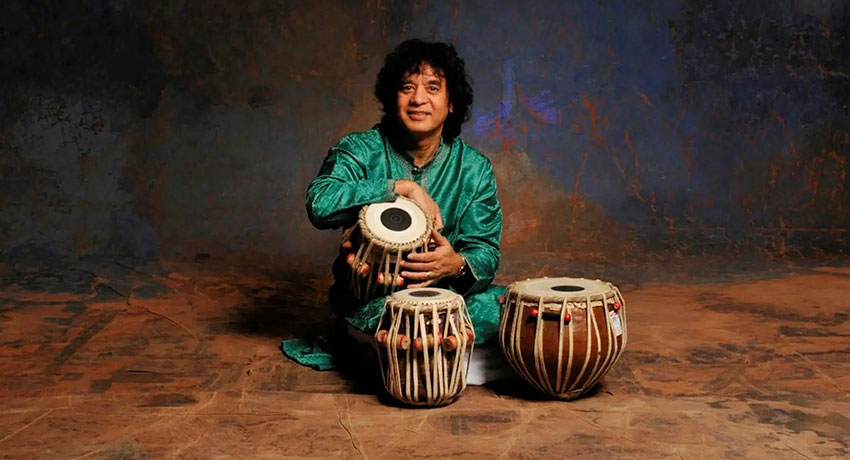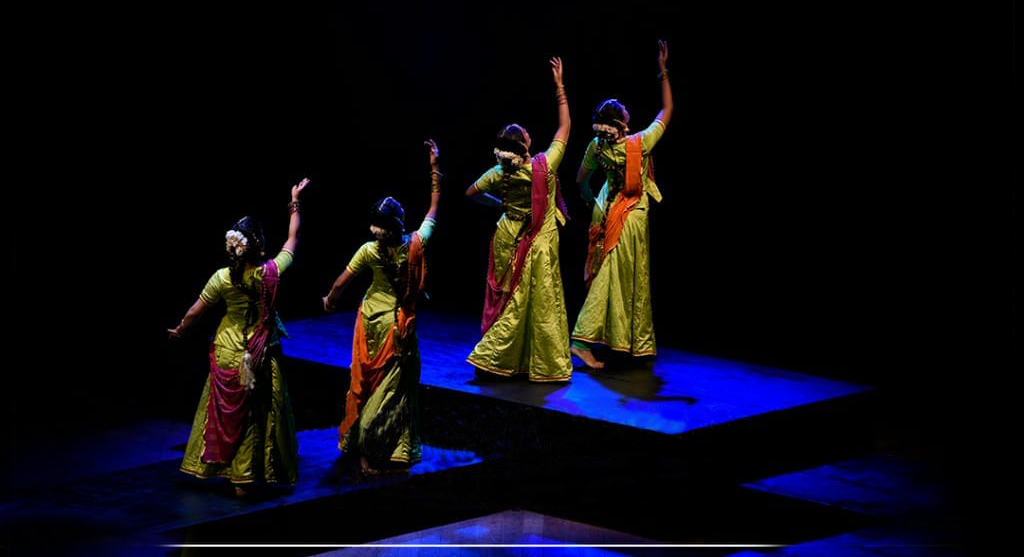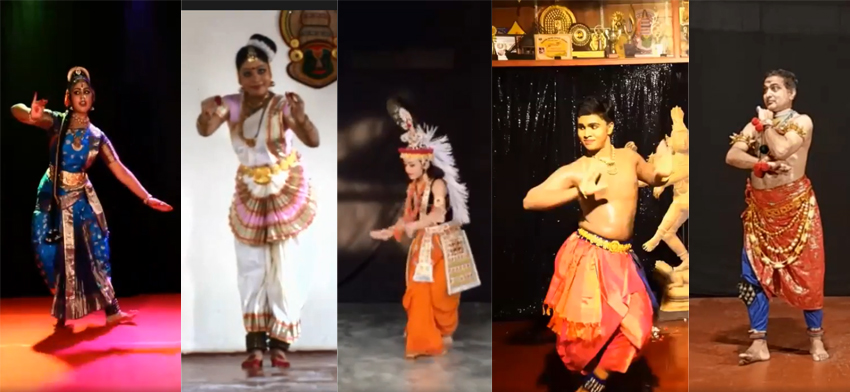Rasikas were immersed in the grandeur of classical dance styles on the first two days of Evam festival. Even the signature tune by Satish Krishnamurthy that raised the virtual curtain on all days showcased Prachi Saathi (Bharathanatyam), Battery Dance Company, New York (Ballet and Modern) and Kasi Aysola (Kuchipudi). The third evening brought to us ‘Venugaan’ by Vaibhav Arekar from Mumbai. An acclaimed Bharathanatyam soloist, Arekar is known for his intellectual, poised and structured approach to form and choreography. By the looks of the title, a well thought out and intense margam or something on similar lines was expected. Boy, were we in for a surprise!
‘Venugaan’ began with Sri Vallabhacharya’s famed Madhurashtakam. Here, Vaibhav Arekar presented a keen description of Krishna as the God we are all familiar with; as Krishna seen through an ardent devotee’s eyes. Replete with beautiful imagery created with angika abhinaya, the ashtakam seemed like the perfect beginning to a full-fledged Bharathanatyam showcase. This was when Arekar spoke and introduced us to the format that would follow. ‘Venugaan’ was essentially scripted as a monologue by Prof. Vasant Dev for theatre alone but Arekar found the possibility of movement coming into it. “A symbiotic relationship between spoken word and movement, where one dissolves into the other. An intricate and intimate relationship of these two art forms rather than interspersing on into the other”, he said. In this work, Krishna was not seen as an exalted God, but as a human being- a vulnerable, mortal, haunted, conflicted human, on the last day of his life, seeking answers from a higher, supreme power- Vidhatha. Arekar’s further declaration that this wouldn’t be a typical Bharathanatyam or dance-drama presentation had us intrigued and curious.
We often associate with the external identity of a person (as was shown in the ashtakam earlier) but often don’t focus on the mind of that person, that place which encompasses their idea and thoughts without any form. This was the focal point in the work that followed. Krishna was sleeping, dreaming or rather being hounded by nightmares, which at once set the precedent mood for the Alaripu, which was a symbolic choice for perhaps the ‘blossoming’ of the last day in Krishna’s mortal life. Only, the blossoming was far from pleasant and soothing and was instead full of conflicting questions enhanced by clever hastas and footwork patterns. Krishna- the warrior, was effectively established with the linear movements that adorn an Alaripu and an interesting video cut to footwork on the sand was a dark and dramatic add to depict the war field that he spent a great part of his life on.
“Mein sirf vahaan tha…”, Krishna utters in almost childlike innocence, questioning why his mere presence on the field should haunt him so. Through the ebbs and flows of poetry, he arrives at an integral point where he wonders why he loves is the body so much. This dialogue effortlessly moved to a rather vain image of Krishna perfuming himself with sandalwood paste and adorning himself with his usual finery. Jayadeva’s Ashtapathi– ‘Chandana charchita’ wafted through at the perfect moment to relive all the moments where Krishna sought and soaked in material and bodily pleasures with the Gopikas. An oft heard composition took on a completely different hue in Arekar’s rueful interpretation for “Uss arthavatee deha ko athaaha pyar diya meine.” The poetic script cannot be translated into English without losing its exacting glory. For example, one can only say that the line which described Krishna’s fingers handling the peacock feather seamlessly integrated with Jayadeva’s lilting lines. To feel the deep emotional effect within, one has to be familiar with Hindi, and poetic Hindi at that, in order to lose oneself into the dreamy echelons of Krishna’s memory, to awaken harshly with him, “Radhe!”
Did his inner demons, so graphically portrayed by Arekar, make him kill Kans? After all, he innocently arrived bearing good tidings at his uncle’s doorstep. What then, made him tear apart elephants and then his own relative? What made him transform to death itself? Loosely translated, he eggs on his Vidhatha, “You created my body to embody power, revolution. Why did you then fill it with disarray and deprive it of peace?” At every juncture of contemplation, Satish Krishnamurthy’s brilliant percussion arrangements and soulful singing by Karthik Hebbar created minimalistic yet powerful support for the segments that followed.
Some extremely thought-provoking questions and statements that will stay with us for a long time arose. While trying to get rid of his weapons, an exasperated Krishna asks, “Why can’t a God’s handhold a flute? Why must it only be a bow and the Sudarshana chakra?” In a single statement, the most powerful weapon of the universe was shunned in favour of a flute! Krishna recalls various crucial ‘game-changer’ incidents of his life in succession. The truth in the poetic verses that followed was so deep and intense that it’s every ripple churned our hearts and brains with equal verve. “Truth is killed so it can roam in the forest of chaos forever”, was the most poignant, relevant and relatable lines that gave way to Krishna’s ultimate realisation, “Did I play or get played; did I dance or was I made to dance; did I arrive or was I brought?” If we were seated in an auditorium, this would probably be the moment where we took out our tissues to dab our eyes as Maa Yashoda called her baby, “Krishna, nee begane baaro…”
This format of dance-theatre was an unprecedented experience for viewers, who thought they were in for a Bharathanatyam performance. This genre, which propels vaachika abhinaya to the forefront also allowed for Arekar to stretch the vocabulary of Bharathanatyam to its limits. His dialogue delivery and sheer vocal stamina modulated the entire production effectively.
Under the keen direction of Sushant Jadav, who also worked the lights, costume and set with inexplicable expertise, ‘Venugaan’ became a spectacle that viewers will never forget. Original theme direction by Hemanth Hazare had a unique flavour and the music direction by Satish Krishnamurthy held us through every single minute. Karthik Hebbar shone in singing his own as well as the popular compositions that dotted the production. Haunting melodies by Sandip Kulkarni’s flute and apt support by Aparna Deodhar on sitar uplifted the performance. An entire video team headed by Payal Jadav, with meticulous editing by Suraj Jadav made for a beautiful viewing experience.
[adrotate group=”9″]
Evam’s final day was supposed to have featured Mavin Khoo’s production, which was postponed due to prolonged lockdowns in the UK. Stay tuned for the final report, once it is aired.
About Contributor- Shilpa Nanjappa is a Bharatanatyam soloist and a disciple of Guru Padmini Ramachandran.










